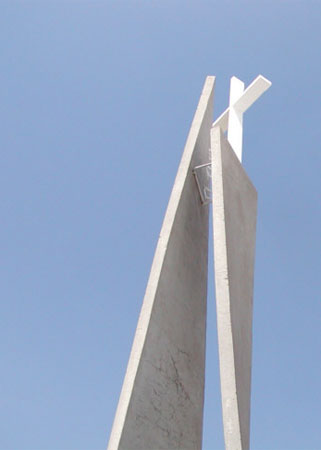- Introduction
- American Evan.
- Holy Cross
- First Christian
- St. Vincent
- Mental Hospital
- Glass & Garden
- Los Arcos
- PVUMC
- St. Maria
- Unitarian Univ.
- Crossroads
Holy Houses!
Midcentury Modern Churches from the Iconic Age of Phoenix
Inside the sanctuary, there's a comfortable community feeling from the 1960s, a space that must help keep the congregation together, a space I find haunting because that spatial feeling of integrated and cooperative community, down to the fixtures and furnishings, feels like my own childhood. Perhaps yours too.  With the obvious resemblance of form between this and the nearby 1960 Coronado High School, both the waffle roof and those thin-shell hyperbolic hyperboloid stems poured on site, this might have been the product of Ralph Haver. But it's not.
With the obvious resemblance of form between this and the nearby 1960 Coronado High School, both the waffle roof and those thin-shell hyperbolic hyperboloid stems poured on site, this might have been the product of Ralph Haver. But it's not.
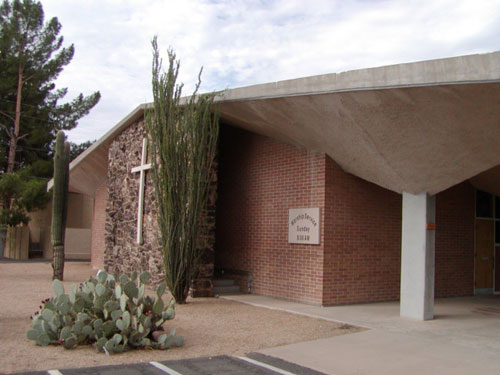 The architect is a name you might not have heard: William D. Knight Jr. Knight and his wife and son and daughter moved to Phoenix from Roswell, New Mexico. Knight had been a product of Texas Tech in Lubbock. He spent three or four productive years in individual practice here, from November 1959 through 1963.
The architect is a name you might not have heard: William D. Knight Jr. Knight and his wife and son and daughter moved to Phoenix from Roswell, New Mexico. Knight had been a product of Texas Tech in Lubbock. He spent three or four productive years in individual practice here, from November 1959 through 1963.
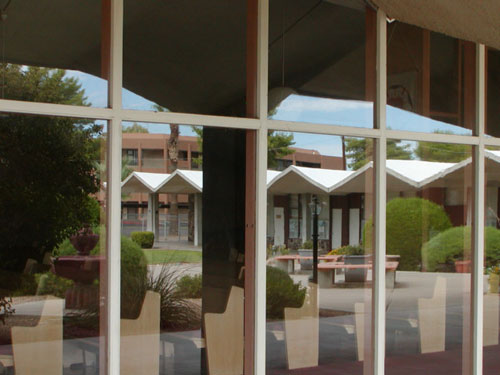 Knight's wife, Elfleda, had her own set of accomplishments, but they collaborated on the sculpture of the altar stone here. They carved it together and gold-leafed the carving and their daughter, quietly observing them work together as a child, now remembers a moment of being so proud of her parents, how talented they both were.
Knight's wife, Elfleda, had her own set of accomplishments, but they collaborated on the sculpture of the altar stone here. They carved it together and gold-leafed the carving and their daughter, quietly observing them work together as a child, now remembers a moment of being so proud of her parents, how talented they both were.
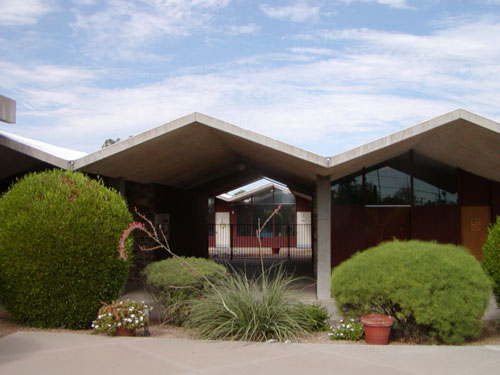 This is one of four major projects Knight worked on during his few years in Phoenix. The Holy Cross Lutheran Church, and another less-dramatic but still worthy Lutheran church in Glendale called St. John's, went just fine. The other two projects convinced him to leave town.
This is one of four major projects Knight worked on during his few years in Phoenix. The Holy Cross Lutheran Church, and another less-dramatic but still worthy Lutheran church in Glendale called St. John's, went just fine. The other two projects convinced him to leave town. One of those was the relatively-well-known City Center Motel downtown. That particular outlandish design does what it was meant to do, catch your eye from the street. Today there's little hope for it, it would have to be entirely rebuilt, and it looks like it could fall down in a cloud of tubercular dust, hold your breath when it does. And it's a visual composition meant to be appreciated at 35 MPH. Knight designed it and unfortunately, his daughter says, his client didn't feel like paying him. Knight ended up in court, it went slow, it was costly. 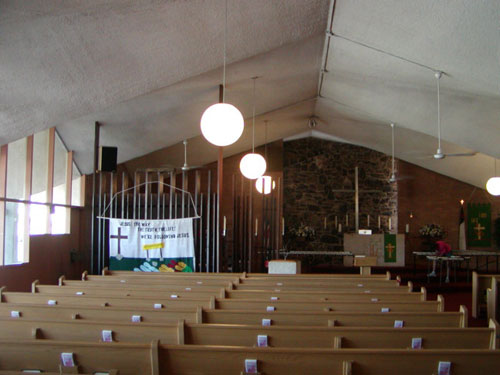 The other problem commission was a local public school. Knight had noticed that it was hot in Phoenix, and not every architect acts on that information, so good for him. Knight also had his attention drawn to the potential of the Russian Army and was kind of an expert on bomb-shelter construction. This was the Cold War era when the Jack Stewarts kept colorful anti-communist literature in the Camelback Inn rooms right next to the Gideon Bible. William Knight puts these facts together and said, Hey!
The other problem commission was a local public school. Knight had noticed that it was hot in Phoenix, and not every architect acts on that information, so good for him. Knight also had his attention drawn to the potential of the Russian Army and was kind of an expert on bomb-shelter construction. This was the Cold War era when the Jack Stewarts kept colorful anti-communist literature in the Camelback Inn rooms right next to the Gideon Bible. William Knight puts these facts together and said, Hey!
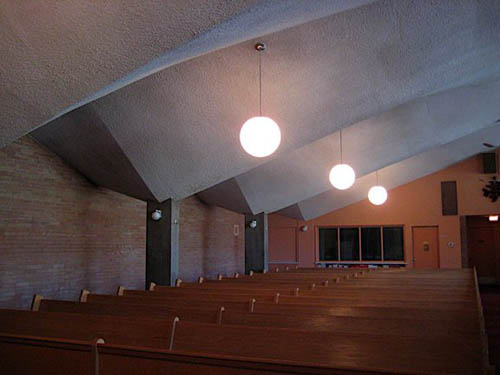 Let's build the school underground! You automatically get integral shade! It's cool down there! You automatically get protection from Russian bombs dropping out of the sky! Soil absorbs radiation, kids safe! And you leave the desert landscape alone! This is another tip-off that Knight was a good & worthy architect, his willingness to advance the design into unknown territory (in this case, the ground) make his project invisible if the conditions suggested it. (And maybe this is the ideal profile for desert architecture, no profile at all.)
Let's build the school underground! You automatically get integral shade! It's cool down there! You automatically get protection from Russian bombs dropping out of the sky! Soil absorbs radiation, kids safe! And you leave the desert landscape alone! This is another tip-off that Knight was a good & worthy architect, his willingness to advance the design into unknown territory (in this case, the ground) make his project invisible if the conditions suggested it. (And maybe this is the ideal profile for desert architecture, no profile at all.)
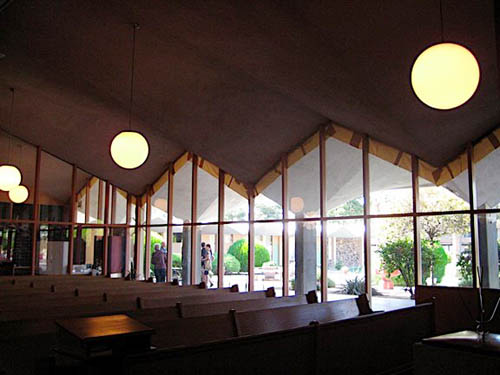 Knight got the green light, spent a lot of time on preparing the drawings, then some small-minded administrator on the school board realized that this was unusual and therefore could not happen. Knight's daughter recalls that there was a big flap, resignations, problems, controversy. Another expensive failure and a true shame we don't have a mid-century underground public school in Phoenix to show off.
Knight got the green light, spent a lot of time on preparing the drawings, then some small-minded administrator on the school board realized that this was unusual and therefore could not happen. Knight's daughter recalls that there was a big flap, resignations, problems, controversy. Another expensive failure and a true shame we don't have a mid-century underground public school in Phoenix to show off.
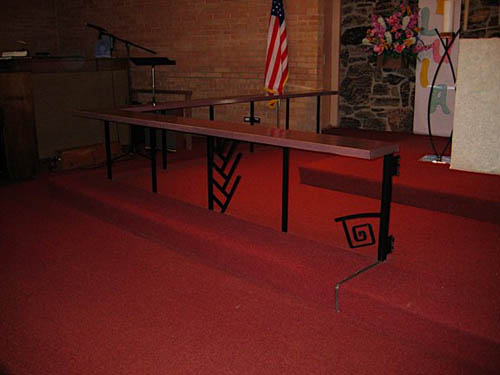 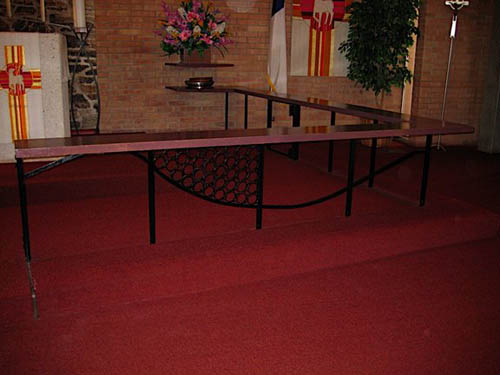 The expense and bad feeling of these two projects chased him out of town. He went to greener pastures in Farmington New Mexico and Window Rock, serving for awhile as the chief architect of the Navajo Nation with work in Window Rock and another church in Fort Defiance. Then Colorado. He died in 1992.
The expense and bad feeling of these two projects chased him out of town. He went to greener pastures in Farmington New Mexico and Window Rock, serving for awhile as the chief architect of the Navajo Nation with work in Window Rock and another church in Fort Defiance. Then Colorado. He died in 1992.
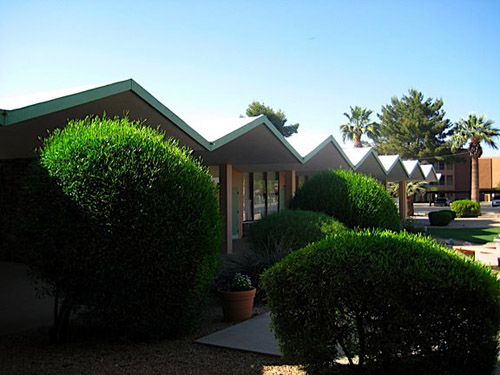 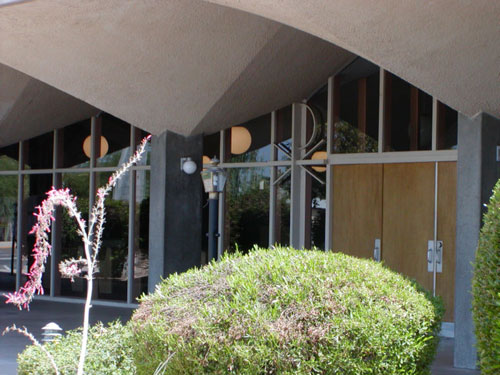 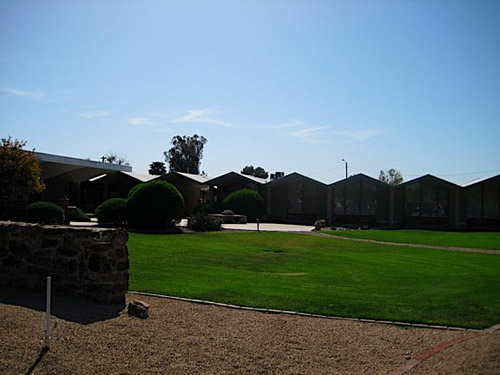 The pastor here remembers that the church was built in an empty landscape, with the exception of the "Peaceful Valley" subdivision south of here, built up in 1955. There are photographs taken from the roof, off towards Camelback, showing the valley in its heartbreaking 1961 emptiness.
The pastor here remembers that the church was built in an empty landscape, with the exception of the "Peaceful Valley" subdivision south of here, built up in 1955. There are photographs taken from the roof, off towards Camelback, showing the valley in its heartbreaking 1961 emptiness. |
